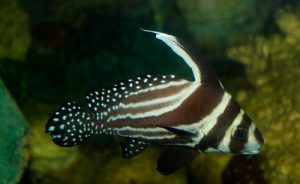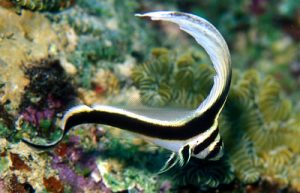

The Spotted Drum can grow to be anywhere between six and ten inches and possesses a distinctive black and white pattern consisting of both dots and stripes and has an unusually long dorsal fin as can be seen on the adult pictured above. As juveniles, they are extremely elegant and beautiful, their patterning consists only of stripes, and they possess an extremely long dorsal fin that becomes shorter as they age.
There is not much in the literature about the purpose of their patterning specifically, but we can draw from information regarding other fish with similar patterns. For example, Angel Fish which are also solitary, possess a similar solid dark banded pattern. This pigment switch from light to dark is a mechanism to confuse predators during an attack.

This fish can also be classified as an odd-shaped swimmer. Odd-Shaped Swimmers are often characterized by a slow and awkward swimming technique. In character with this, Spotted Drums swim around in small repetitive circles. They are solitary fish and are often described as secretive- they are very rarely seen in groups. It does not seem as though they are aggressive or territorial fish because they are very easily approached by divers.
The Spotted Drums spend their days hiding in caves and crevices in reefs in the Bahamas, Bermuda, the Caribbean, and Florida. You will on occasion spot one swimming around the base of the reef during the day. Normally they only come out at night in order to feed on things like small crustaceans, worms, and shrimp. As for predators of the Spotted Drum, according to the literature they are threatened by very little.
The information in this chapter is thanks to content contributions from Allie Tolles
